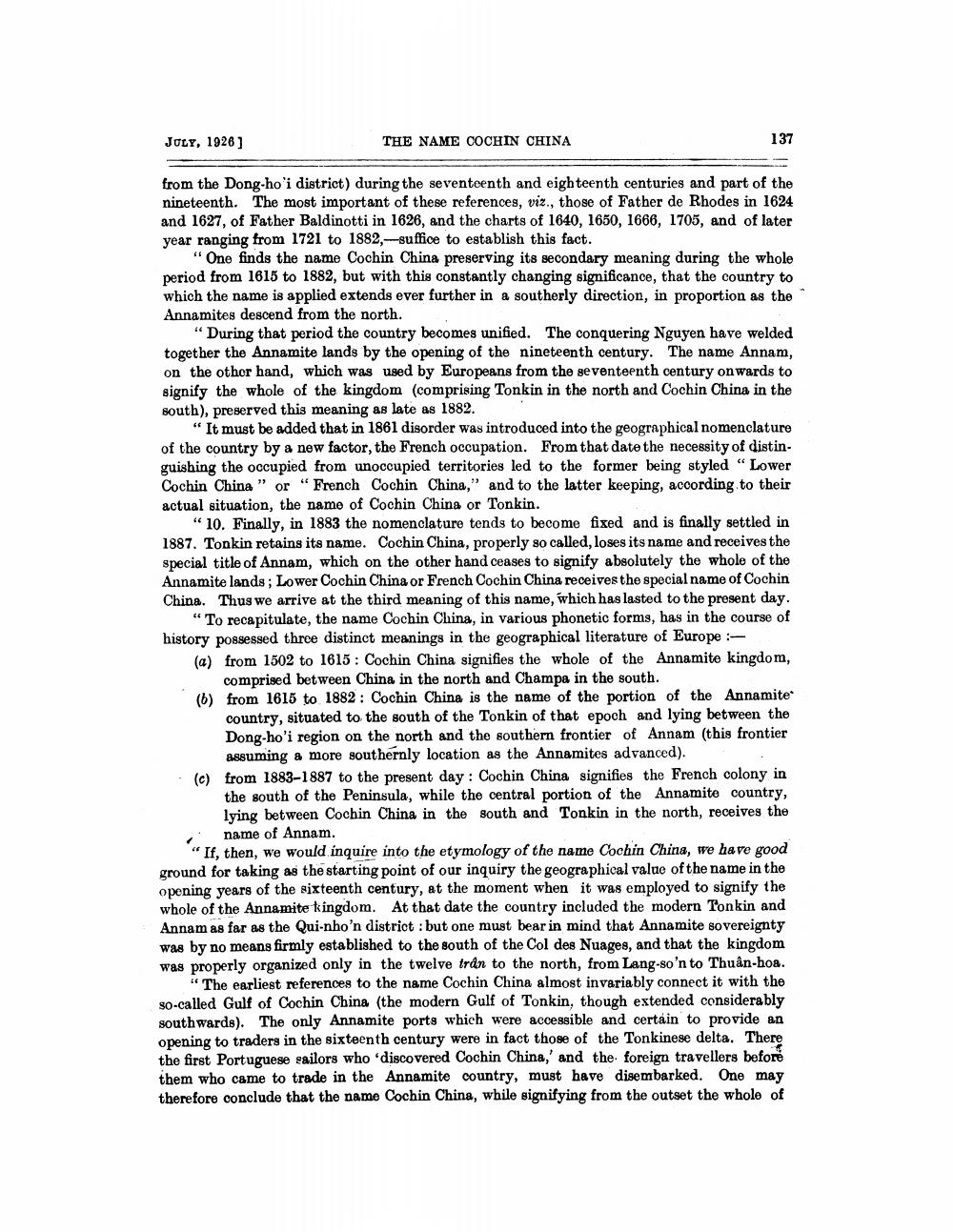________________
JOLY, 1926]
THE NAME COCHIN CHINA
137
from the Dong-ho'i district) during the seventeenth and eighteenth centuries and part of the nineteenth. The most important of these references, viz., those of Father de Rhodes in 1624 and 1627, of Father Baldinotti in 1626, and the charts of 1640, 1650, 1666, 1705, and of later year ranging from 1721 to 1882,--suffice to establish this fact.
"One finds the name Cochin China preserving its secondary meaning during the whole period from 1615 to 1882, but with this constantly changing significance, that the country to which the name is applied extends ever further in a southerly direction, in proportion as the Annamites descend from the north.
"During that period the country becomes unified. The conquering Nguyen have welded together the Annamite lands by the opening of the nineteenth century. The name Annam, on the other hand, which was used by Europeans from the seventeenth century onwards to signify the whole of the kingdom (comprising Tonkin in the north and Cochin China in the south), preserved this meaning as late as 1882.
"It must be added that in 1861 disorder was introduced into the geographical nomenclature of the country by a new factor, the French occupation. From that date the necessity of distinguishing the occupied from unoccupied territories led to the former being styled "Lower Cochin China " or "French Cochin China,” and to the latter keeping, according to their actual situation, the name of Cochin China or Tonkin.
"10. Finally, in 1883 the nomenclature tends to become fixed and is finally settled in 1887. Tonkin retains its name. Cochin China, properly so called, loses its name and receives the special title of Annam, which on the other hand ceases to signify absolutely the whole of the Annamite lands; Lower Cochin China or French Cochin China receives the special name of Cochin China. Thus we arrive at the third meaning of this name, which has lasted to the present day.
"To recapitulate, the name Cochin China, in various phonetic forms, has in the course of history possessed three distinct meanings in the geographical literature of Europe - (a) from 1502 to 1615: Cochin China signifies the whole of the Annamite kingdom,
comprised between China in the north and Champa in the south. (6) from 1615 to 1882: Cochin China is the name of the portion of the Annamite
country, situated to the south of the Tonkin of that epoch and lying between the Dong-ho'i region on the north and the southern frontier of Annam (this frontier
assuming a more southernly location as the Annamites advanced). (c) from 1883–1887 to the present day : Cochin China signifies the French colony in
the south of the Peninsula, while the central portion of the Annamite country, lying between Cochin China in the south and Tonkin in the north, receives the
name of Annam. "If, then, we would inquire into the etymology of the name Cochin China, we have good ground for taking as the starting point of our inquiry the geographical value of the name in the opening years of the sixteenth century, at the moment when it was employed to signify the whole of the Annamite kingdom. At that date the country included the modern Tonkin and Annam as far as the Qui-nho'n district : but one must bear in mind that Annamite sovereignty was by no means firmly established to the south of the Col des Nuages, and that the kingdom was properly organized only in the twelve trán to the north, from Lang-so 'n to Thuân-hoa.
"The earliest references to the name Cochin China almost invariably connect it with the so-called Gulf of Cochin China (the modern Gulf of Tonkin, though extended considerably southwards). The only Annamite ports which were accessible and certain to provide an opening to traders in the sixteenth century were in fact those of the Tonkinese delta. There the first Portuguese railors who discovered Cochin China,' and the foreign travellers before them who came to trade in the Annamite country, must have disembarked. One may therefore conclude that the name Cochin China, while signifying from the outset the whole of




